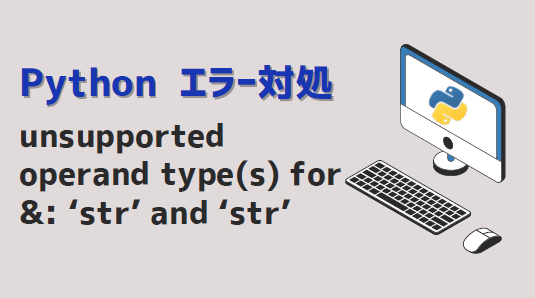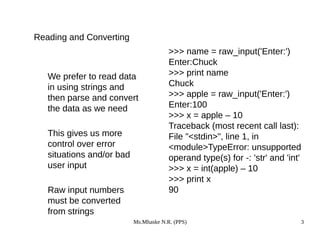Typeerror Unsupported Operand Type S For Str And Str
Python is a dynamic language that allows developers to perform various operations on different types of data. However, when working with strings, you may encounter a common error known as “TypeError: unsupported operand type(s) for str and str”. This error occurs when you try to perform an operation between two string objects that Python does not support.
Common Causes of the TypeError: unsupported operand type(s) for str and str
There are several common causes that can lead to the “TypeError: unsupported operand type(s) for str and str” error:
1. Concatenation of strings with non-string objects: If you try to concatenate a string with a non-string object, such as an integer or a list, Python will raise the TypeError. For example:
“`python
a = “Hello”
b = 42
result = a + b # Raises TypeError
“`
2. Invalid comparison between strings: Comparisons between strings in Python are case-sensitive. If you try to compare strings using invalid operators, such as “>” or “<", Python will raise the TypeError. For example:
```python
a = "apple"
b = "banana"
result = a > b # Raises TypeError
“`
3. Invalid subtraction between strings: Strings cannot be subtracted directly in Python. If you attempt to perform subtraction between two strings, Python will raise the TypeError. For example:
“`python
a = “hello”
b = “world”
result = a – b # Raises TypeError
“`
Troubleshooting the TypeError: unsupported operand type(s) for str and str
To troubleshoot the “TypeError: unsupported operand type(s) for str and str” error, you can follow these steps:
1. Check the types of the operands: Make sure that both operands involved in the operation are indeed strings. Double-check the variables or values being used and confirm their types.
2. Verify the supported operations: Review the Python documentation or relevant resources to check if the operation you are attempting is supported for string objects. For example, string concatenation with the “+” operator is valid, but subtraction is not.
3. Verify the comparison operators: If you are comparing strings, ensure that you are using valid comparison operators like “==” or “!=”. Invalid operators, such as “>” or “<", will raise the TypeError.
4. Use type casting: If you need to perform an operation between a string and a non-string object, you can use type casting to convert the non-string object into a string. This can be done with the `str()` function:
```python
a = "Hello"
b = 42
result = a + str(b) # Converts b to a string before concatenation
```
Handling the TypeError: unsupported operand type(s) for str and str in Python
When faced with the "TypeError: unsupported operand type(s) for str and str" error, there are several ways to handle it:
1. Check for type compatibility: Always ensure that you are performing operations between objects of compatible types. If necessary, use type casting to convert incompatible types into compatible ones.
2. Use conditional statements: If the operands involved in the operation can be of different types, use conditional statements to handle different scenarios. For example, if one operand is a string and the other is an integer, you could perform different actions based on their types.
3. Use try-except blocks: To catch and handle the TypeError, you can use try-except blocks. This allows you to gracefully handle the error by performing alternative actions or displaying informative error messages to the user.
Examples of the TypeError: unsupported operand type(s) for str and str
Here are a few examples that demonstrate situations where the "TypeError: unsupported operand type(s) for str and str" error may occur:
1. Concatenation with a non-string object:
```python
a = "Hello"
b = 42
result = a + b # Raises TypeError
print(result)
```
Output:
```
TypeError: unsupported operand type(s) for str and int
```
2. Invalid comparison between strings:
```python
a = "apple"
b = "banana"
result = a > b # Raises TypeError
print(result)
“`
Output:
“`
TypeError: unorderable types: str() > str()
“`
Working with different data types to avoid TypeError: unsupported operand type(s) for str and str
To avoid the “TypeError: unsupported operand type(s) for str and str” error, it is important to be mindful of the data types you are working with:
1. Convert incompatible types: If you need to perform operations between strings and non-string objects, convert the non-string objects to strings before the operation using the `str()` function.
2. Use explicit type conversion: If you need to compare strings with numbers or perform mathematical operations, explicitly convert the strings into numbers using the `int()` or `float()` functions.
3. Validate input types: If your program receives user input, validate the input types to ensure they match the expected data types. This can help prevent the error from occurring due to incorrect input.
Tips and best practices to prevent the TypeError: unsupported operand type(s) for str and str
To prevent the “TypeError: unsupported operand type(s) for str and str” error, consider the following tips and best practices:
1. Double-check variable assignments: Make sure the variables you are using are assigned the correct values and have the expected data types.
2. Follow Python’s data type rules: Understand the supported operations and comparisons for each data type in Python. Refer to the official Python documentation or relevant resources when in doubt.
3. Write defensive code: Use conditional statements and try-except blocks to handle different scenarios and gracefully handle errors. This includes checking for valid types before performing operations.
Advanced techniques to handle the TypeError: unsupported operand type(s) for str and str
In addition to the basic techniques mentioned earlier, there are some advanced techniques to handle the “TypeError: unsupported operand type(s) for str and str” error in specific situations:
1. Python float to string: To convert a float to a string, you can use the `str()` function or format the float using string formatting methods like `”{:.2f}”.format()`, where `.2f` represents a decimal format with 2 decimal places.
2. Name base_dir db sqlite3 typeerror unsupported operand type s for str and str: This error message may occur in the context of using the SQLite3 database module in Python. It often indicates an issue with the path or formatting of the database file name.
3. Unsupported operand type(s) for -: ‘str’ and ‘int: This error occurs when attempting to subtract a string from an integer. Ensure that the variables being used are of the expected types and convert them if necessary.
4. String compare Python: When comparing strings in Python, use valid comparison operators such as `”==”` or `”!=”`. Be aware that these comparisons are case-sensitive.
5. Convert string to float Python: If you need to convert a string to a float, you can use the `float()` function. However, ensure that the string contains a valid numeric representation to prevent a ValueError.
6. Unsupported operand type(s) for list’ and ‘int: This error occurs when attempting to perform unsupported operations between a list and an integer. Check that both operands are compatible types and convert them if needed.
7. Unsupported operand types: This error message indicates a general issue with mismatched or incompatible types in the operation. Double-check the types of the involved operands and perform type conversions as necessary.
8. Subtract string Python: Remember that strings cannot be directly subtracted. If you need to perform subtraction operations, ensure that the operands are of compatible types, or use appropriate methods for string manipulation.
In conclusion, the “TypeError: unsupported operand type(s) for str and str” error can occur when performing unsupported operations or comparisons between string objects in Python. By understanding the causes and following the troubleshooting steps outlined in this article, you can handle and prevent this error effectively.
Python Typeerror: Unsupported Operand Type(S) For +: ‘Int’ And ‘Str’
What Does Unsupported Operand Type S For Str And Str Mean?
When working with programming languages like Python, you may come across error messages that may seem cryptic at first. One such error often encountered by beginners is the “unsupported operand type(s) for str and str” error. This error can be confusing for those who are not familiar with the technical jargon used in programming languages. In this article, we will delve into what this error means and how to resolve it.
Understanding the Error:
To understand the “unsupported operand type(s) for str and str” error, it is important to know what an operand is in programming. In simple terms, an operand is a value on which an operation is performed. For example, in the equation 2 + 3, the operands are 2 and 3, and the operation is addition.
In Python, certain operations can be performed on different data types, including strings (str) and integers (int). However, there are some operations that are not compatible between certain data types, and this is where the error arises. In the case of the “unsupported operand type(s) for str and str” error specifically, it means that you are trying to perform an operation between two string values that is not supported.
Common Causes of the Error:
1. Concatenation Using the “+” Operator: One common cause of this error is attempting to concatenate two strings using the “+” operator. In Python, the “+” operator is used to concatenate strings. However, if you attempt to use the “+” operator to concatenate a string with a value that is not a string, such as an integer, you will encounter this error.
2. Lack of Proper Data Conversion: Another cause of the error is failing to properly convert a non-string value to a string before performing an operation. For example, if you want to concatenate a string with an integer, you need to first convert the integer to a string using the “str()” function.
3. Incorrect Use of Comparison Operators: This error can also occur when attempting to compare two strings using comparison operators such as “==”, “>”, or “<". These comparison operators are designed to work with numerical values, not strings. To compare strings, you need to use specific string comparison methods or functions. Resolving the Error: Now that we understand the causes of the "unsupported operand type(s) for str and str" error, let's discuss how to resolve it. Here are some possible solutions: 1. Ensure Proper Conversion: Whenever you need to combine a string and a non-string value, make sure to convert the non-string value to a string using the "str()" function. This ensures that both operands are of the same type and can be concatenated without any issues. 2. Use String Formatting: Instead of trying to concatenate strings using the "+" operator, you can use string formatting methods, such as f-strings or the "format()" function. These methods allow you to insert variables or values directly into a string without worrying about compatibility issues. 3. Check for Comparison Operators: If you encounter this error while attempting to compare two strings, review your code and ensure that you are using the correct comparison operators. Depending on your specific needs, you may need to use string-specific comparison methods or functions provided by the programming language. Frequently Asked Questions: Q: Can this error occur with other data types, or is it specific to strings? A: This error can occur when attempting operations between different incompatible data types, not just strings. However, when you see the specific error message of "unsupported operand type(s) for str and str," it means that the error is related to string operations. Q: Why do I need to convert non-string values to strings? A: In Python and many other programming languages, different data types have different behaviors and operations associated with them. To ensure compatibility and avoid errors, it is essential to convert non-string values explicitly to strings when concatenating or comparing them with strings. Q: Are there any other error messages similar to this one? A: Yes, similar error messages can occur when performing operations between incompatible data types. For example, you may encounter "unsupported operand type(s) for int and str" or "unsupported operand type(s) for list and int." The specific error message depends on the data types involved in the operation. Q: How can I debug this error efficiently? A: To debug this error, it is crucial to review your code and identify where the unsupported operation occurs. Pay close attention to any operations involving strings and ensure that you are using the correct data types and operators for the operation you intend. In conclusion, the "unsupported operand type(s) for str and str" error occurs when attempting to perform operations that are not supported between two string values. By understanding the causes and following the suggested solutions, you can effectively resolve this error and improve your code's functionality.
What Is Unsupported Operand Type S For Int And Str In Python?
Python, being a versatile and dynamic programming language, offers numerous functionalities and features to its users. However, as with any programming language, there are certain scenarios where errors or issues may arise. One such issue that Python developers often encounter is the “unsupported operand type(s) for +: ‘int’ and ‘str'” error. This error occurs when trying to concatenate or combine a string with an integer using the “+” operator.
Understanding the Error:
To grasp the concept of this error, it’s crucial to have a basic understanding of data types in Python. In Python, there are different types of data, including integers (int), strings (str), floats (float), and more. Integers are whole numbers, while strings are a sequence of characters enclosed within quotes.
The error message “unsupported operand type(s) for +: ‘int’ and ‘str'” usually occurs when attempting to add or concatenate a string and an integer together using the “+” operator. This operator is used for concatenating two strings or performing numerical addition with two integers. However, when used with a string and an integer, Python does not automatically convert the types, resulting in an error.
Example Scenarios:
Let’s consider some examples to illustrate when this error might occur. Assume we have a variable named “number” of type int and a variable named “text” of type str.
1. Incorrect Syntax:
If we mistakenly write the code as follows:
number = 10
text = “The number is ” + number
Here, we are trying to concatenate “The number is” with the variable “number.” However, since the variable “number” is an integer and not a string, the error “unsupported operand type(s) for +: ‘str’ and ‘int'” will be prompted. The correct way to avoid this error would be to convert the integer to a string using the str() function:
number = 10
text = “The number is ” + str(number)
2. Incorrect Order:
Another scenario where this error may occur is if we mistakenly switch the order of the string and the integer. Consider the following code:
number = 10
text = number + ” is a good number”
Here, we are trying to add the integer “number” with the string ” is a good number.” Since the “+” operator is used for addition, Python attempts to perform numerical addition between an integer and a string, resulting in the error “unsupported operand type(s) for +: ‘int’ and ‘str’.” To avoid this error, we need to reverse the order:
number = 10
text = str(number) + ” is a good number”
3. Using Simple Print Statement:
Sometimes, this error may also occur when trying to print a combination of a string and an integer using the print statement:
number = 10
print(“The number is ” + number)
Here, we are attempting to print “The number is” followed by the value of the variable “number.” Similar to the previous examples, the error “unsupported operand type(s) for +: ‘str’ and ‘int'” will be generated since Python does not automatically convert the integer to a string. To avoid this error, we need to use the str() function to convert the integer into a string as follows:
number = 10
print(“The number is ” + str(number))
Frequently Asked Questions (FAQs):
Q1. Is it possible to concatenate multiple data types without an error?
Yes, Python supports concatenating or combining multiple variables of different data types as long as they are implicitly or explicitly converted to the same data type.
Q2. How can we concatenate strings and integers correctly?
To concatenate strings and integers, we need to explicitly convert the integer to a string using the str() function. This ensures both operands are of the same data type before concatenating them.
Q3. Are there any other operators that can be used for concatenation?
Yes, in addition to the “+” operator, Python also supports the “+=” operator for concatenating strings. For example:
text = “Hello”
text += ” world!”
Q4. Can this error occur with other data types as well?
No, this specific error message occurs when attempting to concatenate a string and an integer. If you try to combine other incompatible data types, you may encounter a different error message.
Q5. Are there any alternatives to concatenation for combining strings and integers?
Yes, if you want to combine strings and integers without using concatenation, you may use the string interpolation method using the “%” operator or the newer f-strings starting from Python 3.6.
Conclusion:
The “unsupported operand type(s) for +: ‘int’ and ‘str'” error in Python arises when attempting to concatenate or combine a string and an integer using the “+” operator. This error can be resolved by explicitly converting the integer into a string using the str() function. Being aware of this error and understanding how to handle it is essential for smooth development and debugging in Python.
Keywords searched by users: typeerror unsupported operand type s for str and str Python float to string, Name base_dir db sqlite3 typeerror unsupported operand type s for str and str, Unsupported operand type(s) for -: ‘str’ and ‘int, String compare Python, Convert string to float Python, Unsupported operand type(s) for list’ and ‘int, Unsupported operand types, Subtract string Python
Categories: Top 20 Typeerror Unsupported Operand Type S For Str And Str
See more here: nhanvietluanvan.com
Python Float To String
Python is a versatile programming language that offers a range of functionalities. The built-in `float` type is one such fundamental feature that allows us to represent and manipulate decimal numbers with utmost precision. However, there are situations where it becomes necessary to convert these float values into string format. This can be due to storing float values as strings in databases, formatting output for user interface, or simply to perform string manipulation operations. In this article, we will explore different techniques to convert Python float to string, covering both basic and advanced concepts.
Converting Float to String – Basic Techniques:
1. Using the `str()` Function:
The simplest and most straightforward way to convert a float to a string is by using the `str()` function. It converts the given value into a string representation, regardless of its original type. For example:
“`
float_num = 3.14
str_num = str(float_num)
“`
In this case, `str_num` becomes a string representation of the `float_num`.
2. Using the `%` Formatting:
Python provides the `%` operator as a formatting technique. This technique allows us to convert a float to a string with a specific number of decimal places. This is achieved by using a formatting specifier, `%f`, which represents a floating-point number. For example:
“`
float_num = 3.14159
str_num = “%.2f” % float_num
“`
In the above example, `str_num` becomes “3.14” since we specified to format the float with two decimal places.
3. Using the `format()` Method:
Python’s `format()` method provides a flexible approach to convert a float to a string. It allows for more complex formatting options and customization than the previous methods. The format specification specifies the number of decimal places, precision, and other characteristics of the resulting string. Here’s an example:
“`
float_num = 5.6789
str_num = “{:.2f}”.format(float_num)
“`
In this case, `str_num` becomes “5.68” as we specified the precision to be two places.
Converting Float to String – Advanced Techniques:
1. Using f-Strings (formatted string literals):
Introduced in Python 3.6, f-strings provide a concise and powerful way to format strings. They allow embedding expressions directly inside string literals by prefixing the string with the letter ‘f’. This technique can also be used to convert a float to a string. Here’s an example:
“`
float_num = 1.23456789
str_num = f”{float_num:.3f}”
“`
In this instance, `str_num` becomes “1.235” since we specified a precision of three decimal places.
2. Converting Float Exponent to String:
In cases where the float value is in the form of an exponent (scientific notation), it is necessary to convert it to a more readable string format. Python offers the `format()` method with an additional specifier `%e` to achieve this. Here’s an example:
“`
exponent_num = 1.23e+10
str_num = “{:g}”.format(exponent_num)
“`
In this case, `str_num` will become “12300000000” as it removes the unnecessary exponent notation and converts it to a regular float.
FAQs:
1. Can I round a float while converting it to a string?
Yes, you can round a float while converting it to a string by using one of the formatting techniques mentioned earlier, such as specifying the number of decimal places.
2. How do I handle float precision during conversion to a string?
Python provides various formatting options that allow you to control float precision during conversion to a string. For example, you can use the `format()` method or f-strings to specify the number of decimal places or significant figures.
3. How can I convert a string back to a float in Python?
To convert a string back to a float in Python, you can use the `float()` function. For example:
“`
str_num = “3.14”
float_num = float(str_num)
“`
In this case, `float_num` will have the value `3.14`.
4. Which method should I use to convert a float to a string?
The method of converting a float to a string depends on the specific requirements of your program. For simple conversions, the `str()` function or `%` formatting may suffice. However, for more complex formatting and customization, consider using `format()` or f-strings.
In conclusion, converting Python floats to strings is a necessary task in many programming scenarios. This article covered various techniques, ranging from basic to advanced, allowing you to choose the most suitable method for your specific needs. Understanding these techniques will provide you with the flexibility to handle float-to-string conversions effectively and efficiently in your Python programs.
Name Base_Dir Db Sqlite3 Typeerror Unsupported Operand Type S For Str And Str
In SQLite, “typeerror unsupported operand type(s) for str and str” is a common error that occurs when trying to concatenate two strings using the “+” operator, but one of the operands is not a string.
To better understand this error, let’s break it down into its components.
TypeErrors occur when an operation or function is applied to an object of an inappropriate type. In this case, we are attempting to concatenate two strings using the “+” operator, but one of the operands is not a string.
The operands in this scenario could be variables, constants, or literals. For example, consider the following code snippet:
“`python
base_dir = ‘/path/to/database/’
db_name = ‘mydb.sqlite3’
db_path = base_dir + db_name
“`
In this code, we are trying to concatenate the `base_dir` and `db_name` variables to obtain the `db_path`. However, if `base_dir` is not defined or assigned a non-string value, a `NameError` will be raised.
To fix this error, ensure that all variables used in the concatenation are defined and have string values. For example, you might want to initialize `base_dir` with a valid string value before using it in concatenation operations.
If you are still encountering this error despite proper variable initialization, you should check if any value that you are trying to concatenate with a string is actually a string. It’s possible that there is an error in the logic that assigns values to variables. In such cases, ensure that all variables involved in string concatenation contain string values.
Frequently Asked Questions (FAQs):
Q: How can I fix the “typeerror unsupported operand type(s) for str and str” error in SQLite?
A: To fix this error, carefully check the values of all variables involved in string concatenation. Ensure that they are all defined and have string values. If any of the variables are not strings, convert them to strings using appropriate methods or functions.
Q: What causes the “typeerror unsupported operand type(s) for str and str” error?
A: This error usually occurs when trying to concatenate strings using the “+” operator, but one of the operands is not a string. It can be caused by variables not being defined or not having string values.
Q: How do I concatenate strings in SQLite without encountering this error?
A: To safely concatenate strings, ensure that all operands involved in the concatenation are defined and have string values. If any of the operands are not strings, convert them to strings explicitly using appropriate methods or functions, such as the `str()` function.
Q: Can this error occur in other programming languages as well?
A: Yes, this error is not specific to SQLite and can occur in other programming languages that support string concatenation, like Python, JavaScript, or Java. The root cause and fix may vary slightly depending on the language, but the core concept remains the same.
Q: Are there alternative ways to concatenate strings in SQLite?
A: Yes, SQLite provides an alternative concatenation syntax using the `||` operator. For example, `base_dir || db_name` achieves the same result as `base_dir + db_name` in our previous example. However, the same considerations regarding the types of operands still apply.
Q: What other types of errors can occur in SQLite?
A: SQLite can generate various types of errors, including syntax errors, constraint violations, and database or table not found errors. It is crucial to handle and address these errors appropriately to ensure the proper functioning of your SQLite database-driven applications. Refer to SQLite’s official documentation for a comprehensive list of error types and their descriptions.
In conclusion, the “typeerror unsupported operand type(s) for str and str” error occurs when trying to concatenate strings in SQLite, but one of the operands is not a string. To fix this error, ensure that all variables involved in the concatenation are defined and have string values. If any variable is not a string, convert it explicitly using appropriate methods or functions. Remember to double-check all variables and ensure they contain the intended values to avoid such errors.
Unsupported Operand Type(S) For -: ‘Str’ And ‘Int
Python is a popular and versatile programming language that is known for its simplicity and readability. However, even experienced programmers encounter errors while writing Python code. One error that you may come across is the “Unsupported operand type(s) for -: ‘str’ and ‘int'” error message. This error occurs when you try to subtract an integer from a string, which is not a valid operation in Python. In this article, we’ll explore this error in depth, understand why it occurs, and discuss how to fix it.
Understanding the Error:
The error message “Unsupported operand type(s) for -: ‘str’ and ‘int'” is raised when you attempt to perform a subtraction operation between a string and an integer. In Python, the ‘-‘ operator is used for subtraction, but it only works with numeric types such as integers and floats. When you try to subtract an integer from a string, Python raises this error to inform you that the operation is not supported.
Example:
Let’s look at an example that demonstrates the error:
“`python
num_str = “10”
num_int = 5
result = num_str – num_int
“`
In this example, we have a string variable `num_str` with the value “10” and an integer variable `num_int` with the value 5. When we try to subtract `num_int` from `num_str` and store the result in the `result` variable, the error “Unsupported operand type(s) for -: ‘str’ and ‘int'” is raised.
Fixing the Error:
To fix the “Unsupported operand type(s) for -: ‘str’ and ‘int'” error, you need to convert the string variable to an integer before performing the subtraction operation. Python provides several built-in functions that can be used for data type conversion. In this case, you can use the `int()` function to convert the string to an integer.
Let’s modify the previous example to fix the error:
“`python
num_str = “10”
num_int = 5
result = int(num_str) – num_int
“`
By using the `int()` function to convert `num_str` to an integer before performing the subtraction, the error is resolved, and the correct result is obtained.
Frequently Asked Questions (FAQs):
Q: What does the error message “Unsupported operand type(s) for -: ‘str’ and ‘int'” mean?
A: This error message indicates that you are trying to subtract an integer from a string, which is not a valid operation in Python.
Q: Why does Python raise this error?
A: Python raises this error to inform you that the subtraction operation is not supported between a string and an integer.
Q: How can I fix this error?
A: To fix the error, you need to convert the string variable to an integer using the `int()` function before performing the subtraction operation.
Q: Are there any other arithmetic operations that can cause similar errors?
A: Yes, similar errors can occur with other arithmetic operations like multiplication (`*`) and division (`/`) when performed between incompatible data types.
Q: Can I perform arithmetic operations between different numeric types in Python?
A: Yes, Python allows you to perform arithmetic operations between different numeric types like integers and floats without any issues.
Conclusion:
The “Unsupported operand type(s) for -: ‘str’ and ‘int'” error occurs when you try to subtract an integer from a string in Python. This error can be fixed by converting the string to an integer before performing the subtraction operation. It is essential to remember that arithmetic operations only work with compatible data types in Python. By understanding this error and its resolution, you can write more robust code and avoid similar issues in the future.
Images related to the topic typeerror unsupported operand type s for str and str

Found 35 images related to typeerror unsupported operand type s for str and str theme







![Typeerror unsupported operand type s for str and float [SOLVED] Typeerror Unsupported Operand Type S For Str And Float [Solved]](https://streaming.humix.com/poster/gaTdZzcYlzzpGtuj/882bd3e3b97969b11e05eb982db81915975addb2946dd334c85f979298a46566_dvJhXP.jpg)










Article link: typeerror unsupported operand type s for str and str.
Learn more about the topic typeerror unsupported operand type s for str and str.
- TypeError: unsupported operand type(s) for /: ‘str’ and ‘str’
- How to fix TypeError: unsupported operand type(s) for -: ‘str …
- Python TypeError: unsupported operand type(s) for -: ‘str’ and …
- How to fix TypeError: unsupported operand type(s) for /: ‘str’ and ‘int’
- TypeError: unsupported operand type(s) for +: int and list
- unsupported operand type(s) for +: ‘NoneType’ and ‘list’ – Anvil Q&A
- TypeError: unsupported operand type(s) for -: ‘str’ and ‘str’
- TypeError: unsupported operand type(s) for +: int and str
- TypeError unsupported operand type s for – str and str – Edureka
- Python TypeError: unsupported operand type(s) for -: ‘str’ and …
- unsupported operand type(s) for +: ‘bool’ and ‘str’ in Odoov10
- TypeError: unsupported operand type(s) for -: ‘str’ and ‘int’
See more: nhanvietluanvan.com/luat-hoc